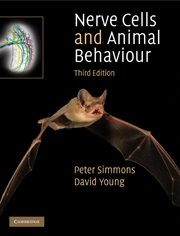Book contents
- Frontmatter
- Contents
- Preface
- 1 Organisation of animal behaviour and of brains: feeding in star-nosed moles and courtship in fruit flies
- 2 Signals in nerve cells: reflexes in mammals and insects
- 3 Neuronal mechanisms for releasing behaviour: predator and prey – toad and cockroach
- 4 Neuronal pathways for behaviour: startle behaviours and giant neurons in crayfish and fish
- 5 Eyes and vision: sensory filtering and course control in insects
- 6 Sensory maps: hunting by owls and bats
- 7 Programmes for movement: how nervous systems generate and control rhythmic movements
- 8 Changes in nerve cells and behaviour: learning in bees and rats; swarming in locusts
- 9 Nerve cells and animal signalling: songs of crickets, electric fish and birds
- References
- Index
- References
3 - Neuronal mechanisms for releasing behaviour: predator and prey – toad and cockroach
Published online by Cambridge University Press: 05 August 2012
- Frontmatter
- Contents
- Preface
- 1 Organisation of animal behaviour and of brains: feeding in star-nosed moles and courtship in fruit flies
- 2 Signals in nerve cells: reflexes in mammals and insects
- 3 Neuronal mechanisms for releasing behaviour: predator and prey – toad and cockroach
- 4 Neuronal pathways for behaviour: startle behaviours and giant neurons in crayfish and fish
- 5 Eyes and vision: sensory filtering and course control in insects
- 6 Sensory maps: hunting by owls and bats
- 7 Programmes for movement: how nervous systems generate and control rhythmic movements
- 8 Changes in nerve cells and behaviour: learning in bees and rats; swarming in locusts
- 9 Nerve cells and animal signalling: songs of crickets, electric fish and birds
- References
- Index
- References
Summary
Imagine a damp forest floor with a toad sitting motionless by a log. An insect scuttles from under the log, moving too fast to identify, and immediately the toad lunges towards the insect, flicking its tongue towards it. The toad misses its meal this time and the insect swivels away from the lunge of the toad and runs for cover; it was a cockroach (Fig. 3.1). These two behaviours, prey capture by toads and escape running by cockroaches, are excellent case studies in neuroethology because both show how it is possible to identify the roles played by individual nerve cells in recognising significant stimuli and triggering appropriate behavioural responses. In these cases, the stimuli require immediate action on the part of the animal. A toad will in fact try to catch and eat any small animal that moves along the ground in front of it; it probably does not hunt for cockroaches in particular. Likewise a cockroach will turn and run away from rapidly accelerating air currents, such as those produced by the sudden strike of any predator including a toad. Toads and cockroaches are not specifically adapted to detect each other, but natural selection has shaped the evolution of effective neuronal mechanisms that enable toads to recognise scuttling insects as a potential meal and cockroaches to escape from predatory assaults. In each behaviour, the animal needs to assimilate sensory information rapidly and to organise its motor response appropriately.
- Type
- Chapter
- Information
- Nerve Cells and Animal Behaviour , pp. 44 - 59Publisher: Cambridge University PressPrint publication year: 2010



